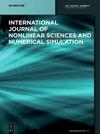用Laguerre多项式的分数次幂广义函数求解Bagley–Torvik方程
IF 1.5
4区 工程技术
Q2 ENGINEERING, MULTIDISCIPLINARY
International Journal of Nonlinear Sciences and Numerical Simulation
Pub Date : 2022-05-03
DOI:10.1515/ijnsns-2021-0120
引用次数: 1
摘要
摘要本文提出了一种求解分数阶微分方程Bagley–Torvik方程的配置方法。由于大多数分数阶微分方程没有精确的解析解,因此需要数值方法。这项研究很重要,因为它提供了一种分数阶微分方程的数值方法。该方法的主要目的是基于Bagley–Torvik方程的Laguerre多项式获得近似解。到目前为止,还没有研究过基于拉盖尔多项式的配置方法来求解Bagley–Torvik方程。这揭示了这项研究的新颖性。近似解的形式是拉盖尔多项式的分数次幂。通过使用Caputo导数,为方程中具有分数导数的项创建矩阵关系。类似地,在方程中计算二阶导数的矩阵关系。然后,通过使用这些矩阵关系和配点,将Bagley–Torvik问题转化为线性代数方程组。这个系统的解给出了假定解的系数。其次,利用残差函数给出了一种误差估计方法,并利用估计的误差函数改进了Laguerre多项式解。然后,将该方法应用于四个实例,得到的数值结果如表和图所示。此外,还与文献中的其他方法进行了比较,因此所提出的方法比其他方法给出了更好的结果。本文章由计算机程序翻译,如有差异,请以英文原文为准。
Numerical solutions of the Bagley–Torvik equation by using generalized functions with fractional powers of Laguerre polynomials
Abstract In this study, a collocation approach is presented to solve Bagley–Torvik equation, which is a class of fractional differential equations. As most fractional differential equations do not have exact analytical solutions, it is needed numerical methods. This study is important because it presents a numerical method for fractional differential equations. The main purpose of this method is to obtain the approximate solution based on Laguerre polynomials of the Bagley–Torvik equation. To date, a collocation method based on the Laguerre polynomials has not been studied for the solutions of the Bagley–Torvik equation. This reveals the novelty of the study. The approximate solution is sought in form of the fractional powers of the Laguerre polynomials. By using the Caputo derivative, the matrix relation is created for term with fractional derivative in the equation. Similarly, the matrix relation of second derivative is computed in equation. Then, by using these matrix relations and the collocation points, the Bagley–Torvik problem is converted into a system of the linear algebraic equations. The solution of this system gives the coefficients of the assumed solution. Secondly, an error estimation method is given with the help of the residual function and also the Laguerre polynomial solution is improved by using the estimated error function. Then, the method is applied to four examples and the obtained numerical results are shown in tables and graphs. Also, the comparisons are made with other methods in the literature and so the presented method gives better results than other methods.
求助全文
通过发布文献求助,成功后即可免费获取论文全文。
去求助
来源期刊
CiteScore
2.80
自引率
6.70%
发文量
117
审稿时长
13.7 months
期刊介绍:
The International Journal of Nonlinear Sciences and Numerical Simulation publishes original papers on all subjects relevant to nonlinear sciences and numerical simulation. The journal is directed at Researchers in Nonlinear Sciences, Engineers, and Computational Scientists, Economists, and others, who either study the nature of nonlinear problems or conduct numerical simulations of nonlinear problems.

 求助内容:
求助内容: 应助结果提醒方式:
应助结果提醒方式:


